The Samsung Galaxy S6 and S6 edge Review
by Joshua Ho on April 17, 2015 9:00 AM EST- Posted in
- Smartphones
- Samsung
- Mobile
- Galaxy S6
- Galaxy S6 Edge
Battery Life
At this point, it really goes without saying that battery life can make or break the experience of a smartphone. The anxiety that is associated with running out of battery is probably one of the worse experiences to have when using a smartphone, which is why good battery life is important. In theory, a phone should never run out of battery in a single day no matter the use case, but battery life is a complex issue to address. It’s common to see people assume that battery capacity and battery life are closely correlated, but this completely ignores total system power draw. Last year, one of the best examples of this was the One M8 compared against the Galaxy S5, which showed a slight edge in favor of the One M8 despite the smaller battery.
The Galaxy S6 and S6 edge are in a similarly peculiar situation. For the past few years, it has gone without saying that battery capacity would increase from year to year, but for the first time ever, Samsung has gone backwards in this regard. The Galaxy S6 has a 2550 mAh, 3.85V battery, which is 91% of the Galaxy S5’s battery. If we simply looked at this metric, it would be rather trivial to simply write off the Galaxy S6 as worse than the S5 in battery life. As previously mentioned, this is a simplistic view of the situation and ignores the other half of the battery life equation.
As a result, we must test battery life holistically, which is far from trivial in most cases. One of the first problems we can encounter in trying to test battery life is display brightness, which can significantly affect results in a battery life test. Although it’s common to standardize at 50% brightness, 50% brightness can be as low as 80 nits or as high as 250 nits depending upon the brightness curve that the OEM sets. In order to avoid this pitfall, we test battery life with the display set to have a 200 nit brightness when displaying a white image. In addition, it’s necessary to have appropriate tests that cover the full curve of performance and power, ranging from a display-bound web browsing use case to sustained, intense CPU and GPU loads.
As with most reviews, our first battery life test is the standard web browsing workload, which loads a set of webpages at a fixed interval, with sufficient time between each page load to ensure that the modem and SoC can reach an idle state. This helps to ensure that faster SoCs aren’t penalized in this test. This test doesn’t exactly match real-world web browsing patterns, but it will give a good idea of relative performance per watt at a constant level of performance.
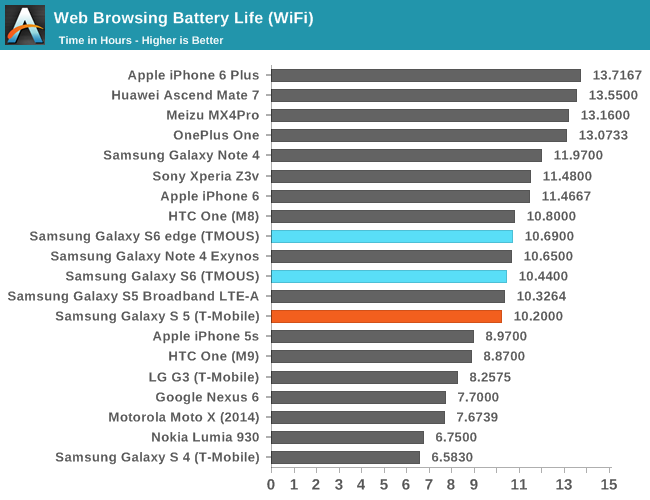
In web browsing, the Galaxy S6 manages to keep battery life while on WiFi at approximately the same level as the Galaxy S5. It’s likely that a combination of the newer Broadcom BCM4358, upgraded AMOLED display, and the Exynos 7420 helped to keep battery consumption relatively constant here, which represents a 10-15% overall power efficiency increase in this test. It’s likely that we’re mostly looking at differences in display efficiency when comparing the 1440p panel of the S6 to the 1080p panel of the S5. It’s definitely impressive that Samsung has pulled this off, but I do wonder what the result would be if Samsung stayed at 1080p.
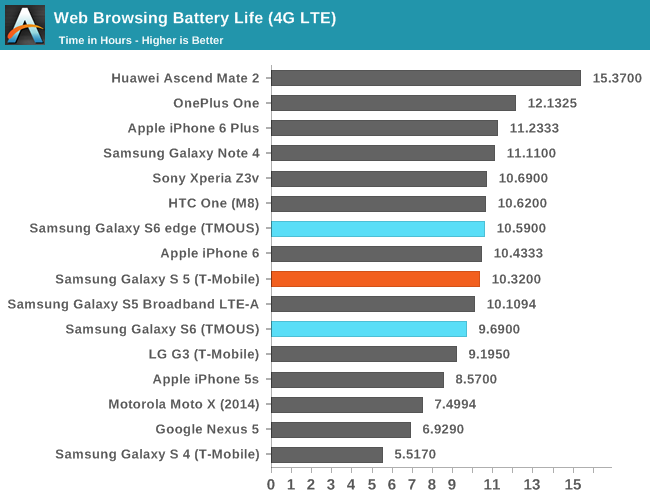
On LTE, we see a pattern that seems to generally mirror devices like the iPhone 6 with an external MDM9x25 Gobi modem. The Shannon 333 modem and Samsung’s other RF front-end components seem to be competitive with Qualcomm’s implementations, but given just how close WiFi and LTE battery life was with the Snapdragon 801 generation I suspect Qualcomm still holds an edge in average RF system power. The difference isn’t massive here, so it’s possible that this could simply be the difference between an external and integrated modem, but we’ll have to do a deeper investigation on power to be sure.
While web browsing is one of the crucial use cases, battery life experiences are often different when looking at multiple points in the curve. In order to get a better idea of battery life in less display-bound use cases, we’ll look at PCMark’s Work Battery Life test. Although not a fixed workload per unit time test like our web browsing test, it avoids strongly emphasizing display power at high APL scenarios and tends to be more CPU and GPU intensive, along with more mixed APL scenarios.

In this test, the Galaxy S6’s runtime in this battery life test is pretty close to the One M8 and One M9, but the major point of differentiation when compared to both is that the score throughout the test is significantly higher. It’s also important to note that the “battery” temperature during the test manages to stay much lower on the Galaxy S6 than on the One M9, which means that the SoC stayed in a more efficient mode of operation throughout the test as power consumption will rise with die temperature due to the way semiconductors work.
Now that we have a good idea of battery life in a display-bound and balanced workload, we can now look at SoC-bound workloads which include GFXBench and Basemark OS II. These tests are almost always limited by how much heat the case of the phone can carry away, and can often reveal weaknesses in how OEMs control throttling if a phone or tablet fails to complete either test. We’ll start by looking at GFXBench, which strongly stresses the GPU similar to an intense 3D game.

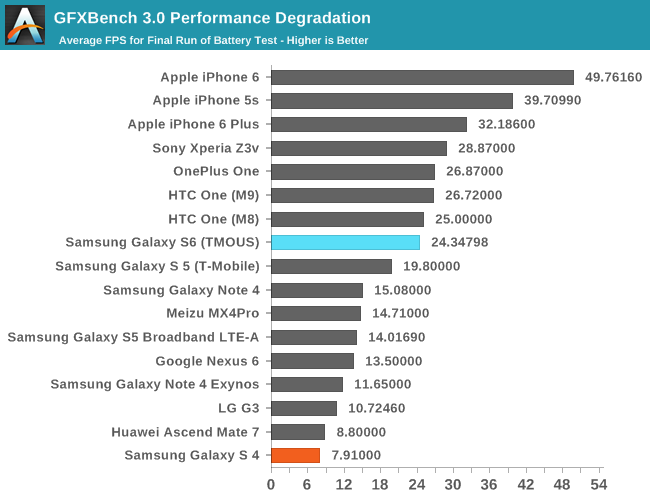
The Galaxy S6 ends up performing around the same level as the One M9 in terms of overall runtime, and the sustained frame rate ends up relatively similar as well. However, it’s critical to add context to this as the Galaxy S6 is running the test at 1440p, while the One M9 is rendering at 1080p. What this means is that the Mali T760 of the Galaxy S6 is sustaining a higher level of performance when compared to the Adreno 430 of the One M9 in this workload, even if that performance is “wasted” on rendering more pixels per frame. The one major issue here that is visible from the FPS vs time graph is that Samsung continues to struggle with graceful throttling as the GPU attempts to always target maximum performance, which causes a strong rise and fall in frame rate as the GPU goes through periods of high and low clock speeds determined by the thermal governor.
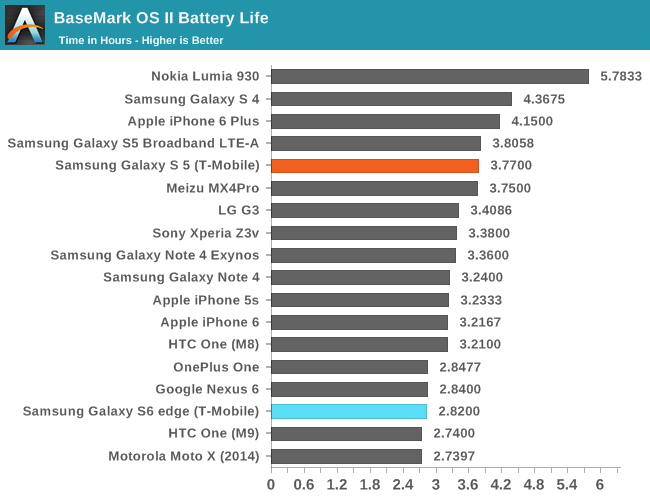
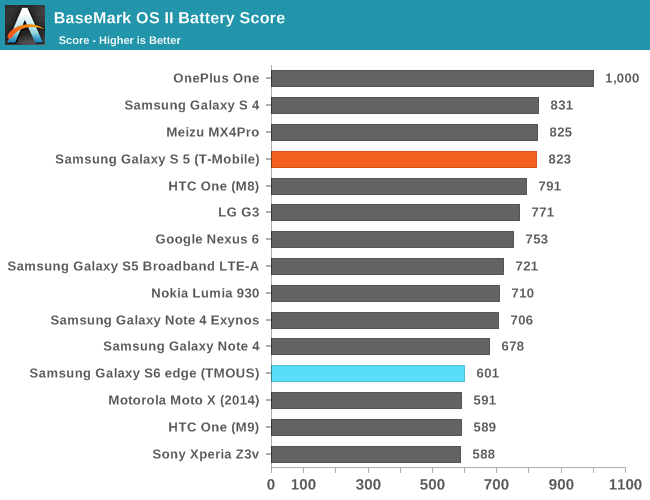
The final battery life test is Basemark OS II’s sustained CPU load test. Although it appears that the Galaxy S6 is comparable to the One M9 in this test, logging CPU frequencies over time reveals that the Exynos 7420 manages to keep the A57 cluster online throughout the course of the test at around 1.2 GHz, while the One M9 is forced to shut off the A57 cluster completely as the phone reaches skin temperature limits. Although both are kept at similar levels of normalized CPU load and run through the test for similar amounts of time, the Galaxy S6 manages to keep the CPU at a significantly higher performance level throughout the test. In general, it’s likely that the Exynos 7420 will be able to sustain overdrive frequencies for longer periods of time due to the massive process node advantages that come with Samsung’s 14LPE process.
Charge Time
Broadly speaking, much of the discourse around battery life as a whole has centered around time off of the charger. We can talk about how many hours of screen on time or total time a phone can spend on a battery, but charging time is often a critical to maintaining mobility. Removable batteries might be able to help with this problem, but if it’s easy to forget to charge a phone overnight, it’s just as easy to forget to charge a spare battery. Charge rate is often crucial for this reason, which is why we attempt to test it. In order to test this, we measure the time it takes to charge from a fully discharged battery to 100% either measured at the wall or indicated by a charging LED. The Galaxy S6 retains the same fast charge protocol as the Note 4, which seems to be QC 2.0 as the AC adapter negotiates fast charging with phones like the LG G Flex 2 and One M8.
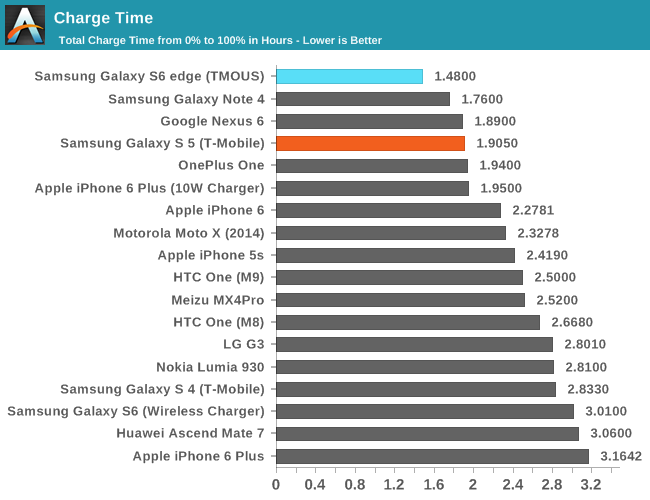
When using the included USB charger, the Galaxy S6 charges incredibly quickly. However, the wireless charger is noticeably slower than the wired charger, which is due to inefficiencies associated with wireless charging and the rather limited charge speed, which is appears to be limited to 1.5 amps at 5 volts. It’s a bit surprising to see that there is no option to disable fast charging the way there was with the Note 4 given that the battery is now sealed and rather difficult to replace, but I suspect most won’t notice a difference in lifetime unless the phone is used for more than 2-3 years.


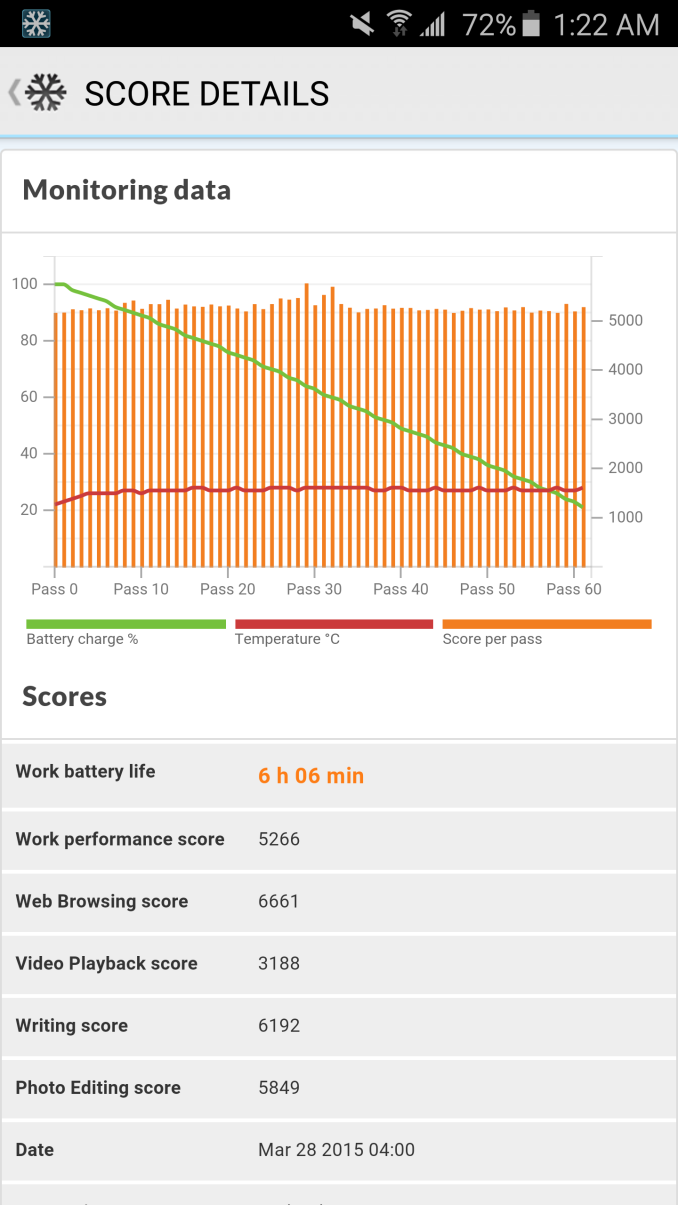
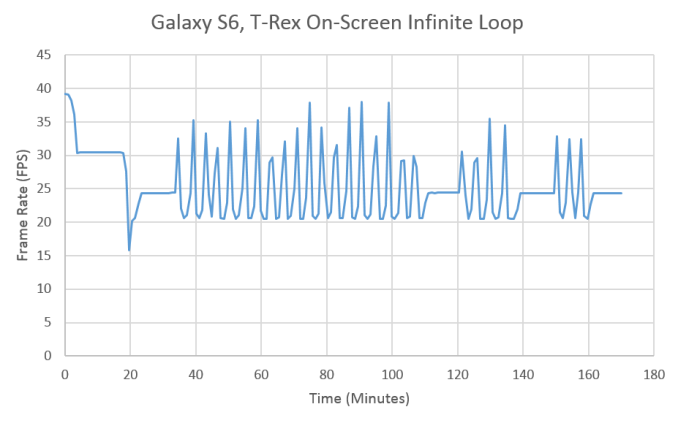
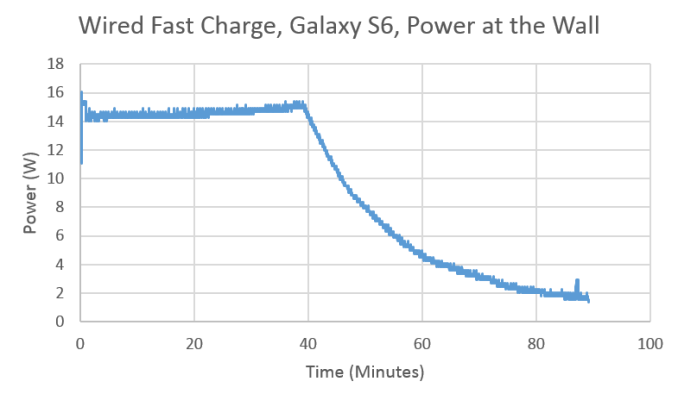
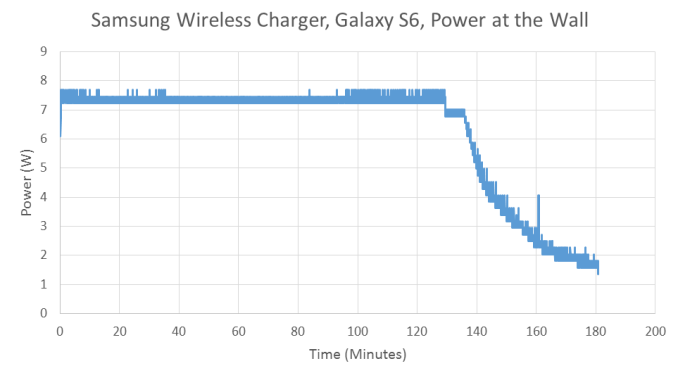








306 Comments
View All Comments
nerd1 - Friday, April 17, 2015 - link
Glad that anandtech FINALLY included the browser benchmarks using sammy's stock browser.lilmoe - Friday, April 17, 2015 - link
It's an improvement. But still, "browser benchmarks" are just that; a benchmark to software side of the browser engine. It's only good for testing CPU performance when we're ONLY looking at generation improvements of the *same* platform/browser/OS.I wish we had a more "open"/transparent cross platform benchmarking suite... Anyway, it looks Exynos is truly back as a market leader, as in being a generation above everything else. I'd expect it to stay in lead well till the Note 5 is here.
nerd1 - Friday, April 17, 2015 - link
"Although the dynamic range of the Galaxy S6’s IMX240 sensor is inherently lower than an equivalent 1.5 micron pixel-size sensor due to the nature of CMOS image sensors"This is not true. Pixel size rarely affects daylight dynamic range of the sensor. D800 series (36MP FF sensor) has actually tiny bit wider dynamic range than 12MP FF sensor of A7s.
Alien959 - Friday, April 17, 2015 - link
Yes, that's true for dslr's because they still have large enough pixel size so dynamic range isn't affected. Even d800 have many times larger pixel photo sensor than 1.5 micron used in SG6. For bigger densities in smaller sensors dynamic range is lower compare some high end compact like panasonic LX7 and cheap point and shoot.nerd1 - Friday, April 17, 2015 - link
Various review sites direct comparison between phone cameras and Note 4/GS6 actually had LESS highlight clipping than iPhone 6.Alien959 - Friday, April 17, 2015 - link
Yes, I have read some of the so maybe sony definitely improved the sensor so samsung is using that versus their own. Different generation sensor and processing also affect the final image.Hairs_ - Friday, April 17, 2015 - link
It's a very hindsight-heavy negative view of the s5 in this review. I'm surprised sales weren't great for it as it fixed most of the issues with the s4's performance and camera.Losing waterproofing, removable battery and SD card are killers for me but apart from that I don't see what makes the s6 a brilliant. The improved software performance will hopefully be brought down to older devices, the improvements in SOC design and battery efficiency are offset by the pointless resolution increase, and the mantra "must follow apple's cue to be considered premium" isn't convincing.
Switching to white backgrounds for apps wastes the advantage of AMOLED as well.
Still, it's selling well so I doubt Samsung care.
lilmoe - Friday, April 17, 2015 - link
The GS5 didn't sell well because of "perception", not merit. It was a HUGE upgrade over the GS4 in almost every aspect IMHO. I'm one of those who actually liked the "band-aid" plastic back. I would have preferred if Samsung made the GS6 closer to the Alpha's design; metal frame with plastic back, but less squarish (IE: the same exact shape/corners of the GS6 but with the same plastic back as the Alpha).I believe that Samsung nailed the design with the Alpha and Note 4, but it seems that reviewers and consumers didn't agree. That stupid twisting of the back cover by reviewers to prove that it was "flimsy" only proved that they were completely ignorant of the quality of materials and the functionality/practicality it entails.
Ammaross - Friday, April 17, 2015 - link
Yep. It's the reviewers that forced Samsung's hand into copying the metal+glass design that the iPhone has. Personally, I think it's horrible as the S6's glass back makes it far too slippery in-hand. I'm definitely putting a bumper on it just so I can hold on to it (which of course entirely defeats the metal+glass design anyway!). Plastic does not mean "cheap," merely flexible (in application/texture, not just robustness).FlushedBubblyJock - Friday, April 17, 2015 - link
Well, yes, I agree, the reviewers had nothing but disdain if it wasn't "the solid and simple apple industrial design that feels expensive in my hand" but add in the drooling sheep and parrots in their responses, they certainly totally contributed as well.Since these people function on mindless perception, not facts, we have the cloned result.